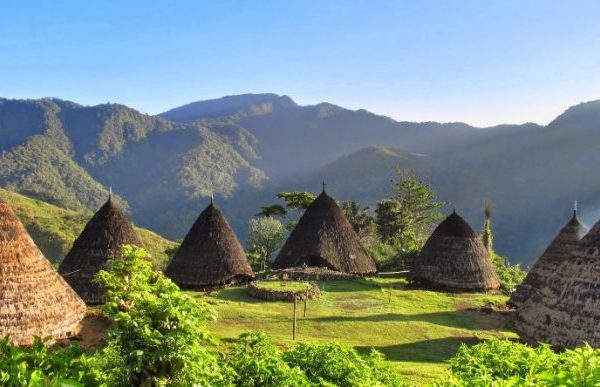Indonesia, which is rich in natural beauty, never seems to make us stop to be amazed. One of the portraits of Indonesia’s natural beauty can be found in the village of Wae Rebo in West Manggarai, Flores-East Nusa Tenggara. Wae Rebo Village, which is geographically located at an altitude of 1,200 meters above sea level, has earned it the nickname of the village above the clouds, because this area is always shrouded in a thin white fog with cool air that calms your heart and mind. Wae Rebo Village is a traditional village that is only inhabited by 112 families or around 700 people. It is said that the Wae Rebo people are descendants of the Minangkabau people who came about a thousand years ago.
All residents are scattered in seven traditional houses called Mbaru Niang. In Wae Rebo only seven Mbaru Niang are allowed, not more. Mbaru Niang is a traditional Flores traditional house which is the main attraction of this village. In Manggarai language, Mbaru Niang means house because one part of the house is used to store sacred heirloom drums used to communicate with the ancestors. This traditional house is in the form of a cone built in the traditional way with a roof made of palm fiber that almost touches the ground. This cone shape symbolizes the never-ending brotherhood in Wae Rebo while in the middle there is a sturdy pillar to support the house which symbolizes Wae Rebo ancestors as its focal point.
Mbaru Niang is about 15 meters high with five stories made of worok wood and bamboo with rattan to tie the construction. At the first level, it is called lutur, which means a tent that functions as a place to live and gather family. Then at the second level it is called lobo which functions as a place to store food and daily necessities. The third level is called lentar, which is used to store the seeds of plants such as corn, rice, and beans. The fourth level is called lempa rae which is used as a place to store food stocks in case of drought. Then the latter is called the hekang code which functions as a place to store offerings for offerings to the ancestors.
Its unique shape and preservation have earned Mbaru Niang an award at the UNESCO Asia-Pacific Award 2012 in the category of Award of Excellence given to conservation buildings that are more than fifty years old. The beauty of Wae Rebo is not only limited to the Mbaru Niang building, but also the surrounding scenery. Wae Rebo is surrounded by green mountains and hills, making this village always shrouded in fog. At night, you can clearly see the Milky Way star cluster if the sky is clear. Meanwhile, in the morning, you can join in pounding coffee or weaving a cloth called cura cloth with brightly colored motifs. Coffee and songket cloth are the advantages of Wae Rebo.
For those who want to come to Wae Rebo, you can take a plane from to Labuhan Bajo, from here you can take a detour through Denge village, which is the closest village to Wae Rebo by using a vehicle for eight hours. After arriving at Denge village, then you can walk to Wae Rebo for about four hours. Even though you have to do trekking for a long time, the view of rice fields, green hills, and beautiful beaches can make you fascinated so that without knowing it, you have arrived at Wae Rebo village. When you get there, you must undergo a ritual that aims to ask permission and protection from the ancestral spirits of the guests who come. Before this ritual is finished, you are not allowed to take photos or do other activities.
Not only local tourists who come to Wae Rebo, but also foreign tourists from various parts of the world. According to local data, there are around 300 foreign tourists who come every year from the Netherlands, France, Australia, and many more. Since Wae Rebo is a traditional village, there are several rules that you must obey such as dressing modestly and not wearing mini clothes. Apart from being polite, the air here is very cold. You are also prohibited from showing affection, cursing and saying harsh words.
